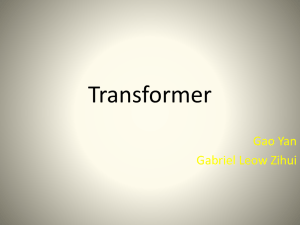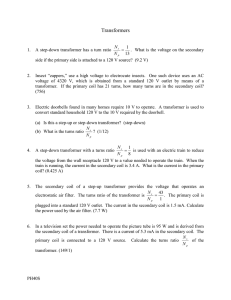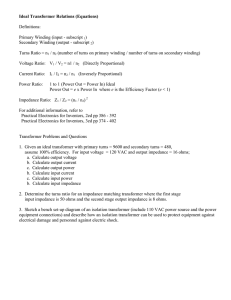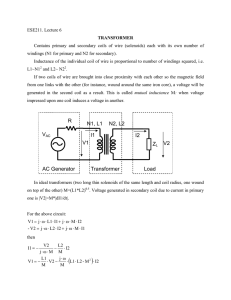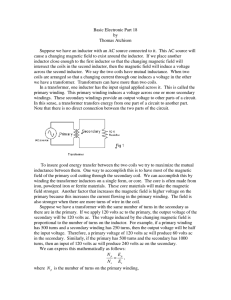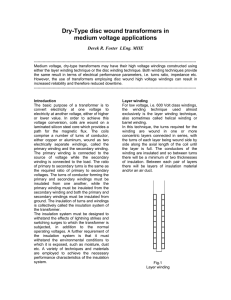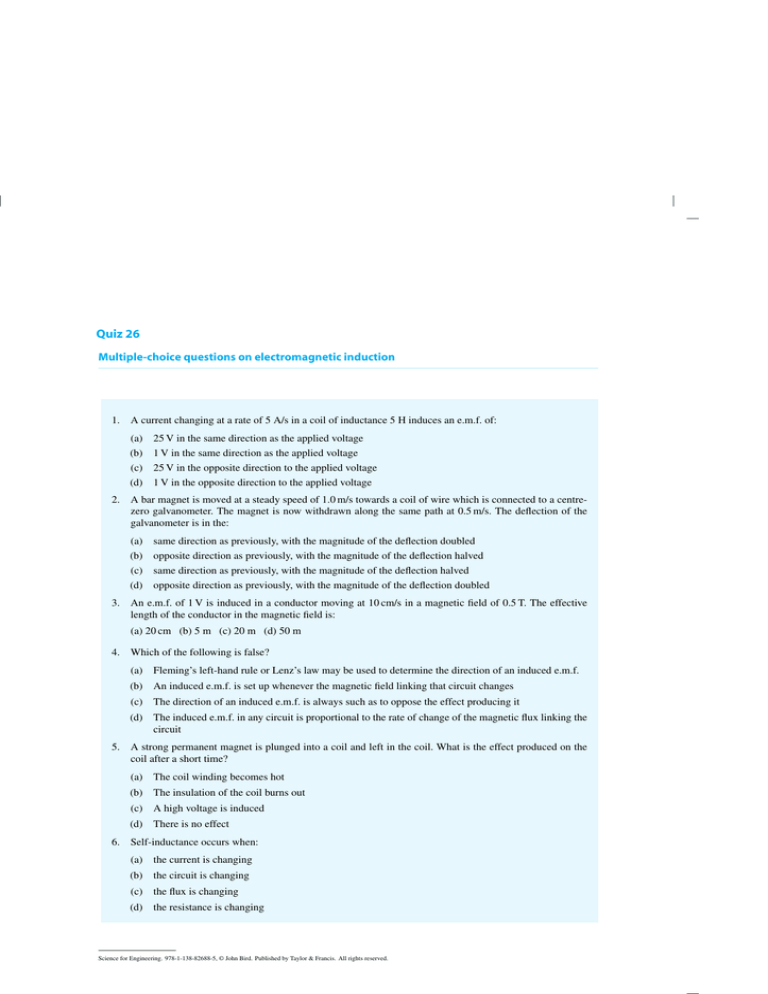
Quiz 26
Multiple-choice questions on electromagnetic induction
1.
A current changing at a rate of 5 A/s in a coil of inductance 5 H induces an e.m.f. of:
(a)
(b)
(c)
(d)
2.
3.
25 V in the same direction as the applied voltage
1 V in the same direction as the applied voltage
25 V in the opposite direction to the applied voltage
1 V in the opposite direction to the applied voltage
A bar magnet is moved at a steady speed of 1.0 m/s towards a coil of wire which is connected to a centrezero galvanometer. The magnet is now withdrawn along the same path at 0.5 m/s. The deflection of the
galvanometer is in the:
(a)
(b)
same direction as previously, with the magnitude of the deflection doubled
opposite direction as previously, with the magnitude of the deflection halved
(c)
(d)
same direction as previously, with the magnitude of the deflection halved
opposite direction as previously, with the magnitude of the deflection doubled
An e.m.f. of 1 V is induced in a conductor moving at 10 cm/s in a magnetic field of 0.5 T. The effective
length of the conductor in the magnetic field is:
(a) 20 cm (b) 5 m (c) 20 m (d) 50 m
4.
5.
6.
Which of the following is false?
(a)
Fleming’s left-hand rule or Lenz’s law may be used to determine the direction of an induced e.m.f.
(b)
An induced e.m.f. is set up whenever the magnetic field linking that circuit changes
(c)
The direction of an induced e.m.f. is always such as to oppose the effect producing it
(d)
The induced e.m.f. in any circuit is proportional to the rate of change of the magnetic flux linking the
circuit
A strong permanent magnet is plunged into a coil and left in the coil. What is the effect produced on the
coil after a short time?
(a)
The coil winding becomes hot
(b)
The insulation of the coil burns out
(c)
A high voltage is induced
(d)
There is no effect
Self-inductance occurs when:
(a)
the current is changing
(b)
the circuit is changing
(c)
the flux is changing
(d)
the resistance is changing
Science for Engineering. 978-1-138-82688-5, © John Bird. Published by Taylor & Francis. All rights reserved.
7.
Faraday’s laws of electromagnetic induction are related to:
(a)
(b)
(c)
(d)
8.
the e.m.f. of a chemical cell
the e.m.f. of a generator
the current flowing in a conductor
the strength of a magnetic field
The mutual inductance between two coils, when a current changing at 20 A/s in one coil induces an e.m.f.
of 10 mV in the other, is:
(a) 0.5 H (b) 200 mH (c) 0.5 mH (d) 2 H
9.
A transformer has 800 primary turns and 100 secondary turns. To obtain 40 V from the secondary winding,
the voltage applied to the primary winding must be:
(a) 5 V (b) 20 V (c) 2.5 V (d) 320 V
10.
A step-up transformer has a turns ratio of 10. If the output current is 5 A, the input current is:
(a) 50 A (b) 5 A (c) 2.5 A (d) 0.5 A
11.
A 440 V/110 V transformer has 1000 turns on the primary winding. The number of turns on the secondary
winding is:
(a) 550 (b) 250 (c) 4000 (d) 25
12.
A 1 kV/250 V transformer has 500 turns on the secondary winding. The number of turns on the primary
winding is:
(a) 2000 (b) 125 (c) 1000 (d) 250
The power input to a mains transformer is 200 W. If the primary current is 2.5 A, the secondary voltage
is 2 V and assuming no losses in the transformer, the turns ratio is:
(a) 80:1 step-up
(c) 80:1 step-down
(d) 40:1 step-down
An ideal transformer has a turns ratio of 1:5 and is supplied at 200 V when the primary current is 3 A.
Which of the following statements is false?
The turns ratio indicates a step-up transformer
The secondary voltage is 40 V
The secondary current is 15 A
The transformer rating is 0.6 kVA
(e)
(f)
The secondary voltage is 1 kV
The secondary current is 0.6 A
4. (a)
5. (d)
9. (d)
10. (a)
14. (b) and (c)
(a)
(b)
(c)
(d)
3. (c)
8. (c)
13. (d)
14.
(b) 40:1 step-up
Answers
1. (c)
2. (b)
6. (a)
7. (b)
11. (b) 12. (a)
13.


